Blog
March 21st, 2013
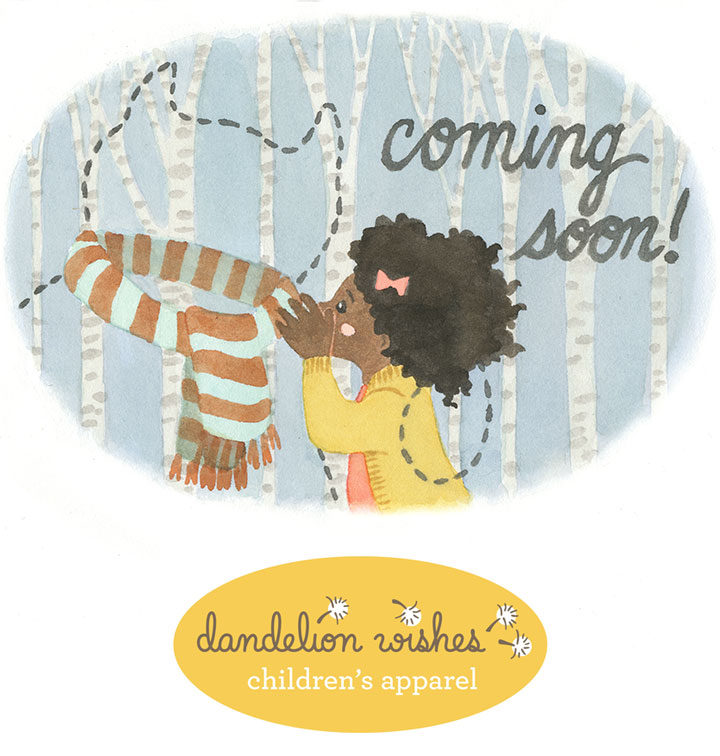
Well, I can finally let you in on the secret, because “coming soon” is about to be switched to “now open.” My friend Susan has spent years building her children’s apparel business, Dandelion Wishes, from idea to brick-and-mortar store—and I’m the lucky gal she asked to help her develop the look and brand of her shop.

Susan is putting the finishing touches on the place, and making sure everything is pitch-perfect for her grand opening this weekend—
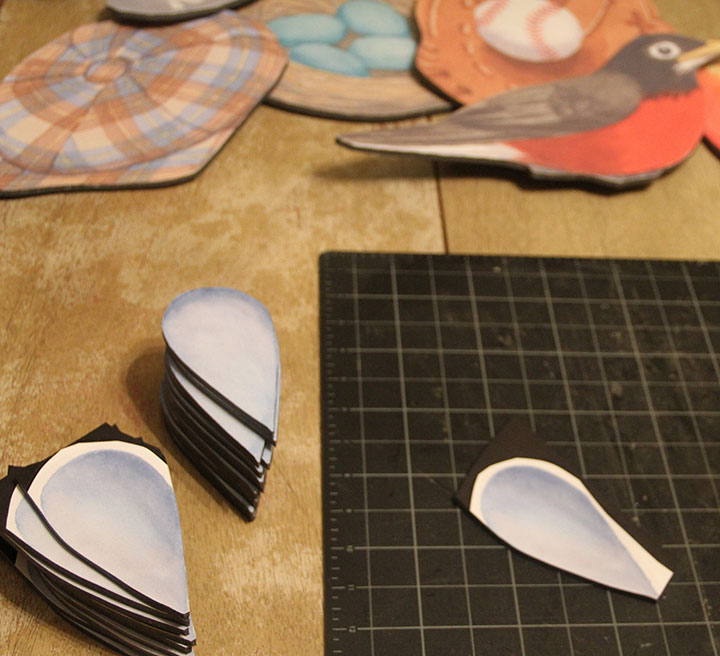
while I’m piecing together (literally!) the final visual details.
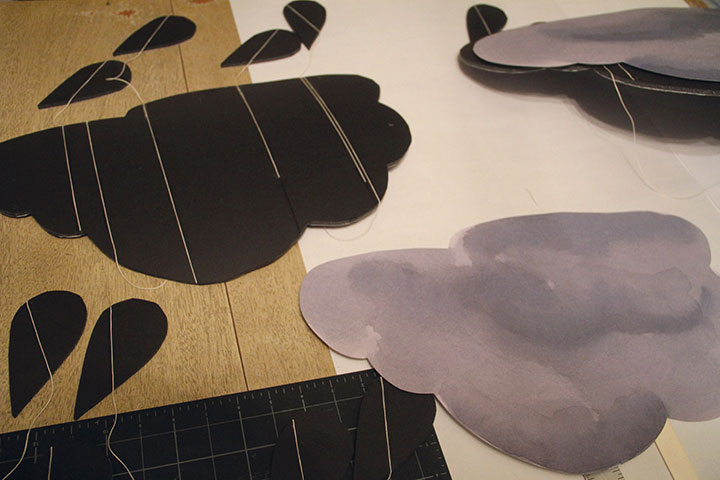
(I’ll reveal more about that on the blog at a later date; or if you’re local, come to the grand opening and see for yourself!)
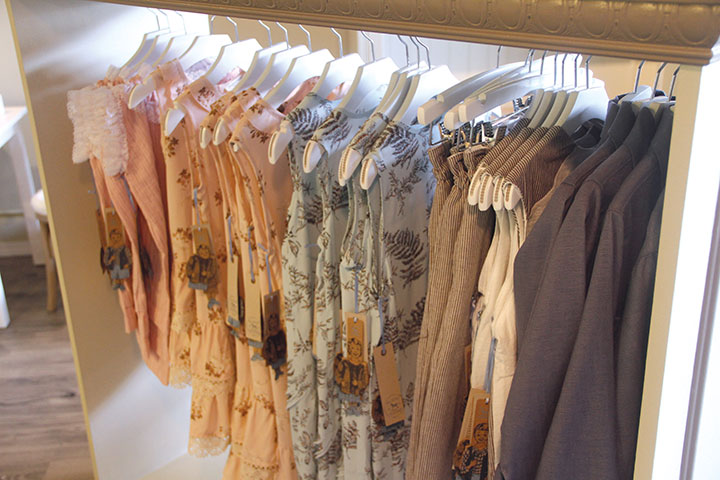
Dandelion Wishes isn’t your average kids’ store; this is something really special. Susan has curated a beautiful collection of clothing, accessories and gifts that paints a picture of what she believes in (and so do I): Support independent artisans. Buy local and domestic whenever possible. Choose natural fibers over synthetic ones. Offer the highest quality available. Bring these ideals into affordable balance and you’ll bring good design within reach.
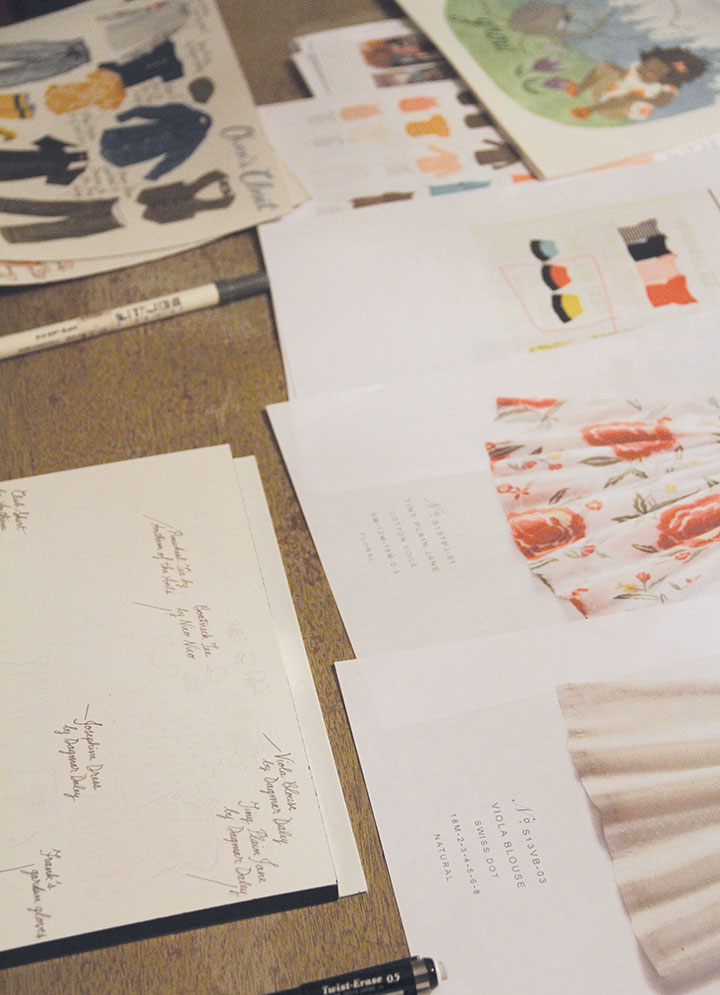
This project was something special, too. I’ve done lots of identity and branding work for clients, but I’ve never had this much free reign before, to help develop the entire conceptual basis for a business. It was so much fun to dive in and really see what I could do.
Since Susan’s shop is so invested in this story, I wanted to create a story out of the shop. Together we invented a world of characters and narratives that make stepping into the shop feel like stepping into a children’s book. Each character has a story and a secret wish, and a personality that fits the different brand stories of the clothing companies Susan carries.
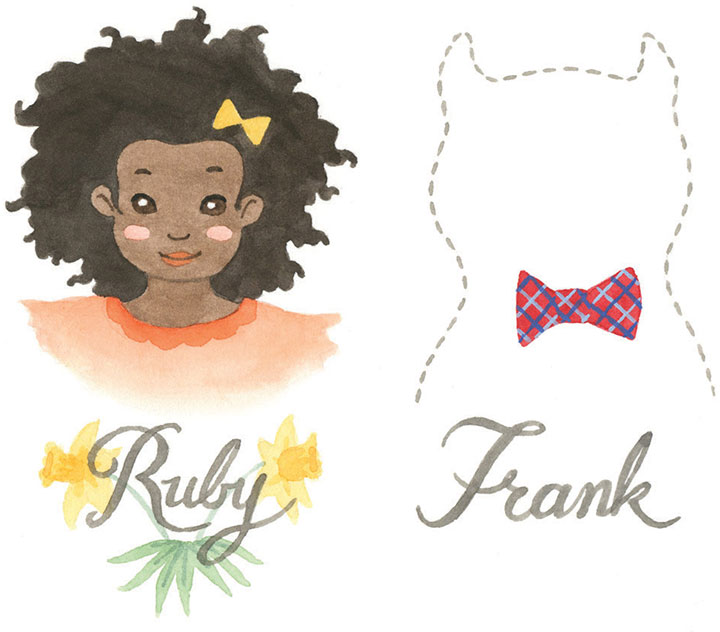
You’ve already met Ruby and her imaginary friend at the start of this post.
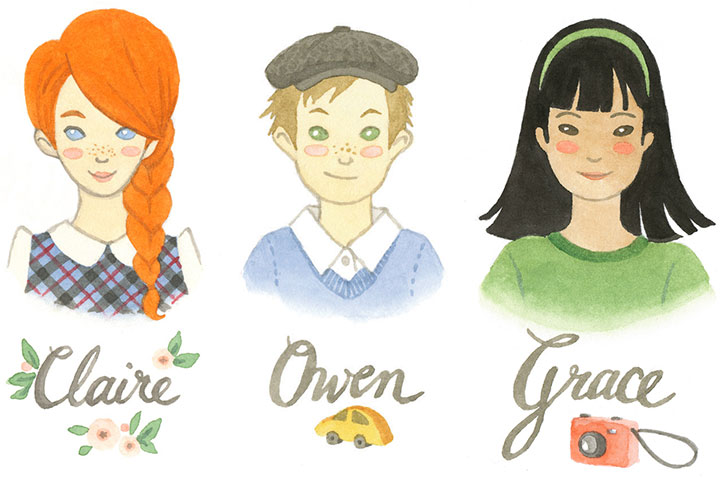
And here’s the rest of our quintet. Once we had our full cast of characters, it made building the shop’s collection of clothing much easier. All of a sudden, Susan was piecing together the wardrobes of actual people with personalities and tastes and preferences—rather than just an inventory list in her head.
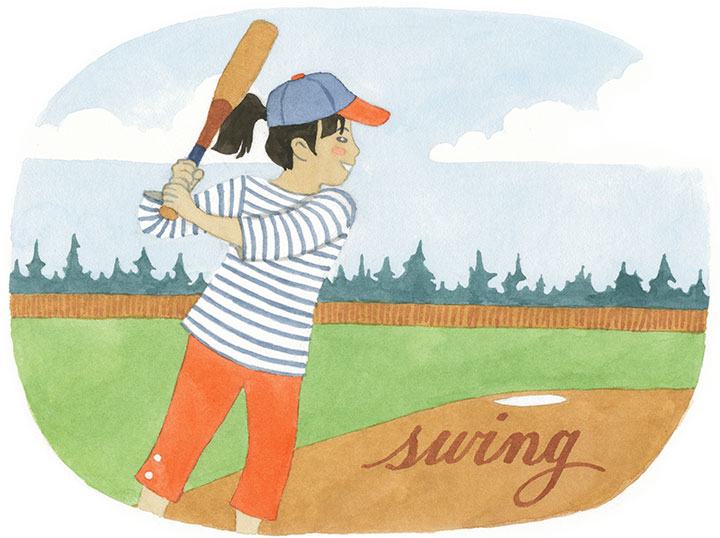
I loved weaving the stories behind each character—
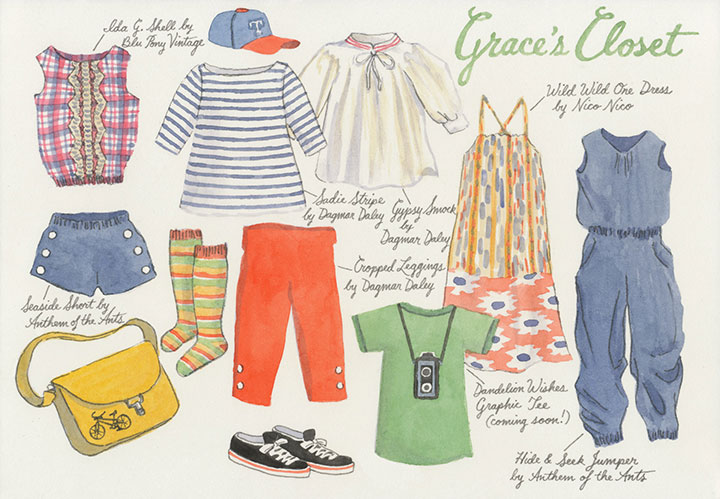
—and getting to mix actual clothing samples with whatever else I felt like dreaming up.
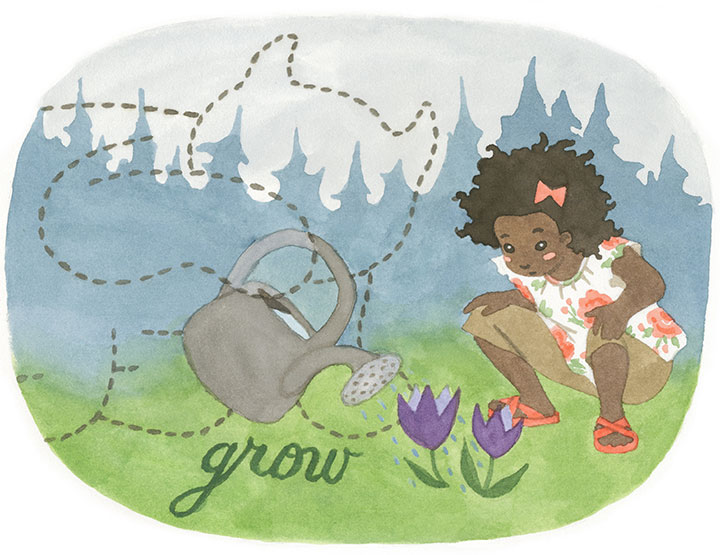
As the seasons change—
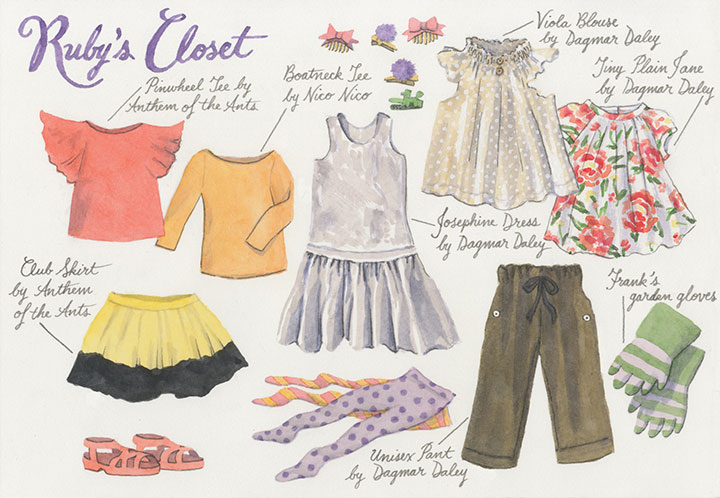
—and so do the kids’ outfits—

we’ll be creating new stories and scenes to go with them. Keep an eye on the shop’s website to watch the tale unfold.
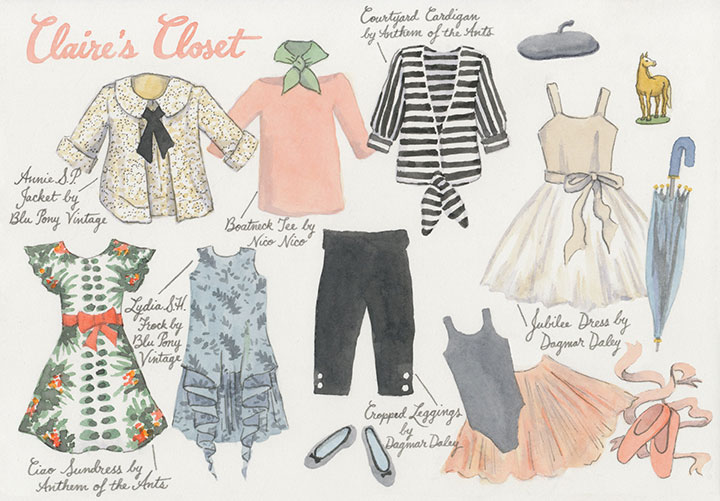
In the meantime, I already find myself thinking of these kids as real people that I know—and wondering what they’d think of each idea I sketch out for the future.

So help Susan make a splash with Dandelion Wishes—if you’re in the Tacoma area, stop by the shop this weekend. And look for an online shop to appear soon.

For now, I’m going to ask Frank what his summer plans are.
December 4th, 2012
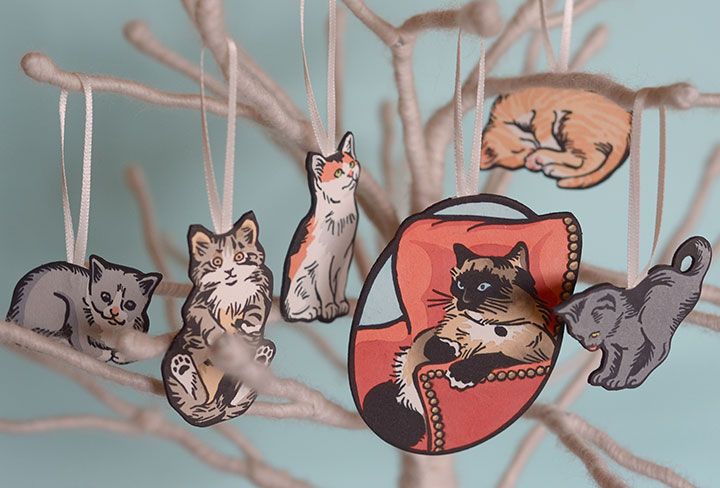
Photo by Laurie Cinotto
Right now my little cottage-industry factory is churning out Christmas—starting with this year’s letterpress ornament collection. This is the second year I’ve made letterpress ornaments, and I have been dying to show you this year’s crop.
Thankfully, I can finally let the…ahem…cat out of the bag.
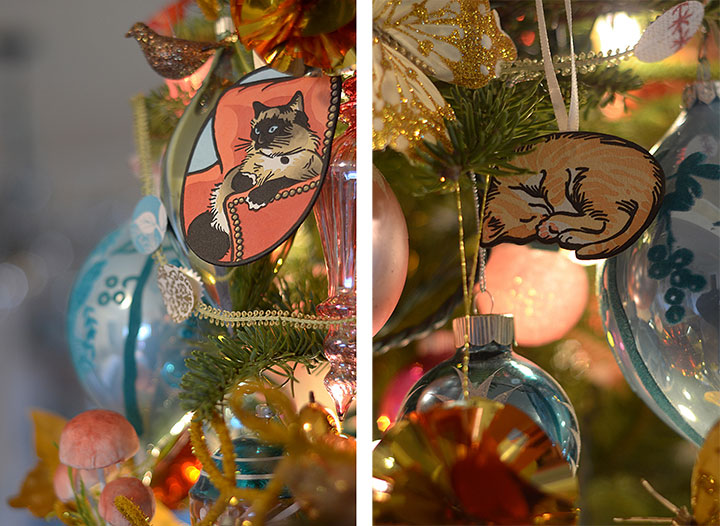
Look at Laurie’s amazing tree! She is the queen of holiday decorating.
There are two sets of ornaments this year, and for one of them I collaborated with my friend Laurie Cinotto, the fabulous fine-craft genius and kitty wrangler behind the insanely wonderful Itty Bitty Kitty Committee. A year ago I asked her if she’d be interested in doing a set of kitty ornaments, and for months now we’ve been positively chortling over these things. (Curious fact: we make nearly identical chortle sounds.)
The really hard part was picking which kittens from Laurie’s nearly endless alumni and gorgeous photographs to illustrate. In the end, I settled on a few of my all-time favorites: Clovis Ashby, who is a bit of a Tacoma celebrity. Extra-pretty Victoria Anne McGillicuddy in all her calico glory. Aloysius Petrie for his “Who, me?” look. My particular friend Baxter Lamm, who now makes mischief full-time at Jessica’s house. And Pearla Dearborn, to whom my secret heart belongs forever (even though she doesn’t live with me). And watching over the flock is Laurie’s own Empress Mama cat, Charlene Butterbean.
These kitties (and Laurie’s photographs) are T-town legends, as I found out this weekend. We did a little ornament test-drive at a local craft fair, and people kept saying things like, “Hey, that’s Clovis on that tree!” and “Wait a minute—what is Charlene Butterbean doing at your table?” But whether these guys are old hat for you, or you’re a dog person who’s never heard of such a thing as kitten blogs on the Internet—well, I just dare you to tear your eyes away from Laurie’s world.
There are just 200 sets of these ornaments to go around, and each one is ridiculously handmade. To give you an idea of just how ridiculous, I thought I’d walk you through part of the process.
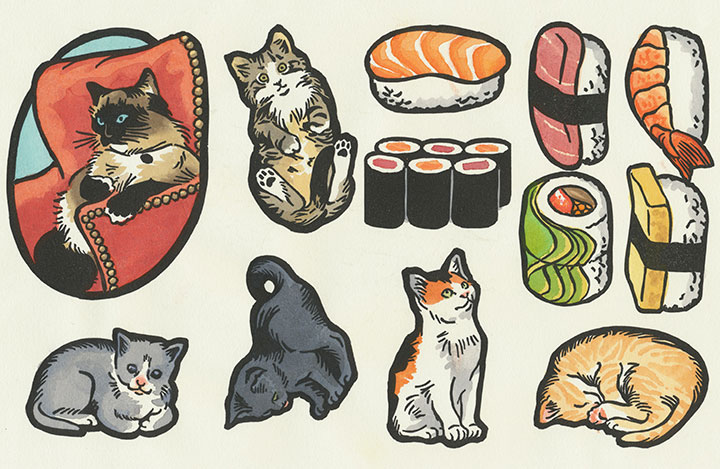
Yes, there’s sushi on that press sheet. That’s the other ornament set this year…
Y’all know my printing process pretty well by now, so I’m going to skip ahead a bit. Just FYI, these are linocuts; check out my bird prints if you’re curious about that process. But as you can see, I printed both ornament sets all at once, on one press sheet.

Then I went ahead with my usual hand-coloring assembly line.
No, wait a minute. I said 200 prints, right? Well, that’s a small edition for retail goods, but when you’re hand-painting each one, 200 feels more like eleventy billion.
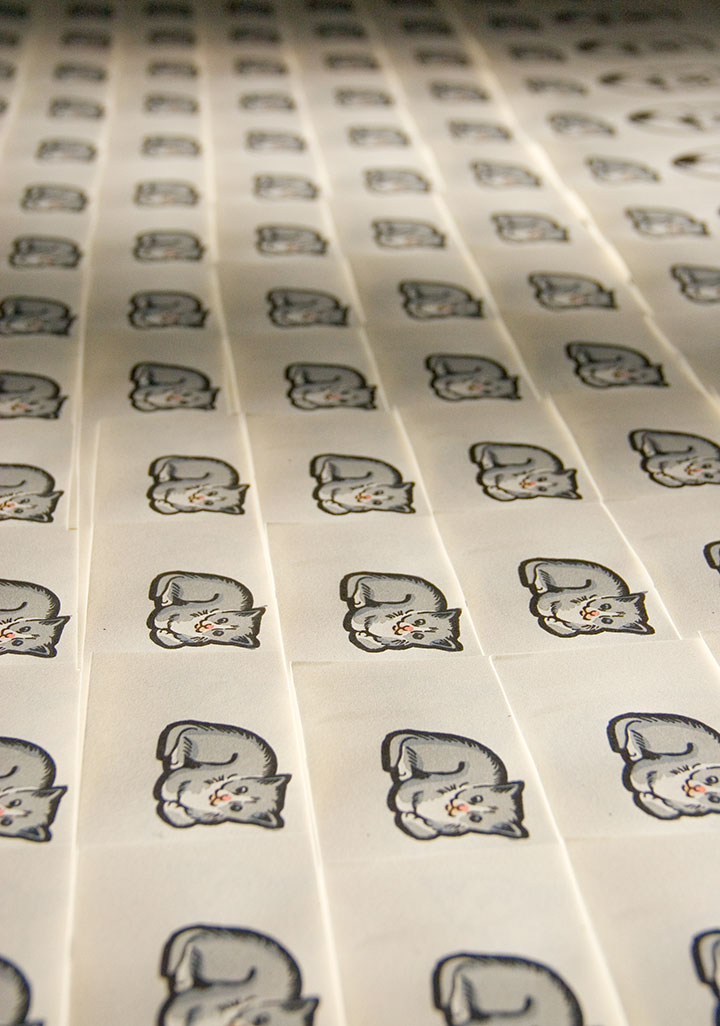
There, that’s more of an accurate picture.
Still, if the work stretching endlessly ahead of you to the horizon is a bunch of drawings of kittens, it’s impossible not to be happy about it, despite yourself. I know—I tested the hypothesis, and I’m still grinning like a fool.
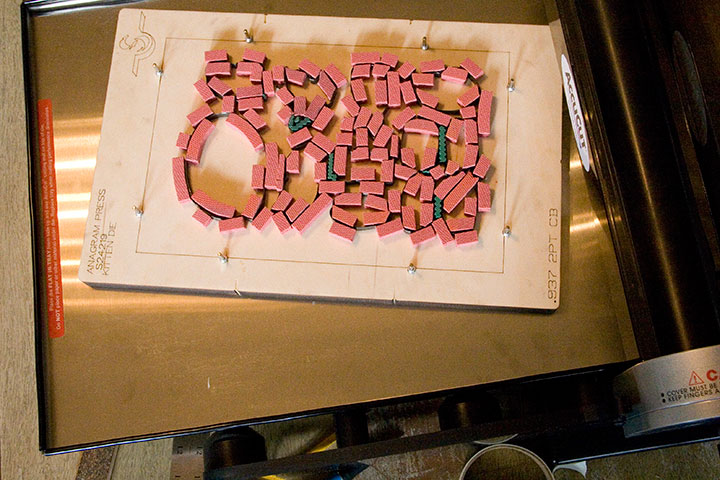
This year I added a new step to the process: rather than hand-cutting all 1200 kitties in the set by hand (ahem, Local Conditions, I’m looking at you!), I made the design simple enough that I could semi-automate part of the assembly line. I bought a hand-crank die-cutting machine, created a digital dieline (basically an industrial pattern) of my design, and sent it off to a friendly steel rule manufacturer in Kent.

I know that plank with all those pink foam bits doesn’t look anything like an ornament set, so let me zoom in. A die consists of steel blades embedded in a piece of wood. The blades are bent and arranged in precisely the configuration specified by the dieline. Those pink foam bits cushion the blades, hold the paper in place and help with cutting accuracy. When the die is run through the cutting machine (which works much like a Vandercook press), those pink bits squish down under pressure, exposing the blades and gripping the paper to be cut. Those metal pins sticking up are for lining up the press sheet—they’re spring-mounted, so they retract when the blade goes through the cutting machine.
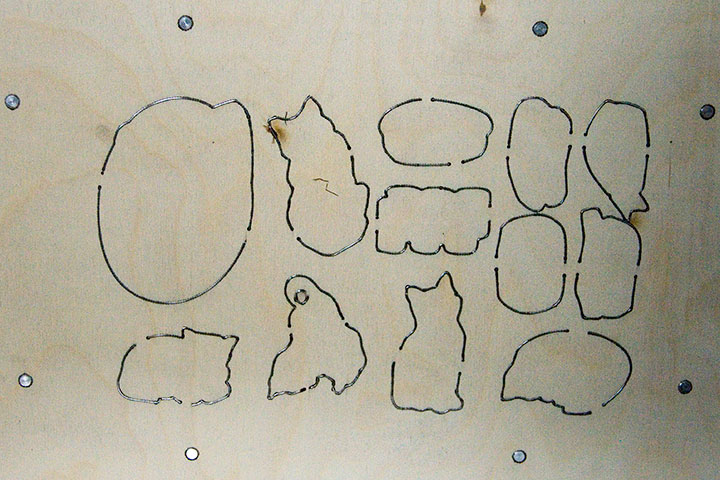
Here’s the underside of the die—now you can see how the blades fit the press sheet.
Still, while the die is a total lifesaver in terms of cutting time, the lightweight paper I was cutting made for some wiggle room—even with the extra line tolerance I built into the design. After all that hand-coloring I didn’t want to lose a third of my prints by cutting them in the wrong place. So I still had to do some puzzling and figure out how to outsmart the limitations here.
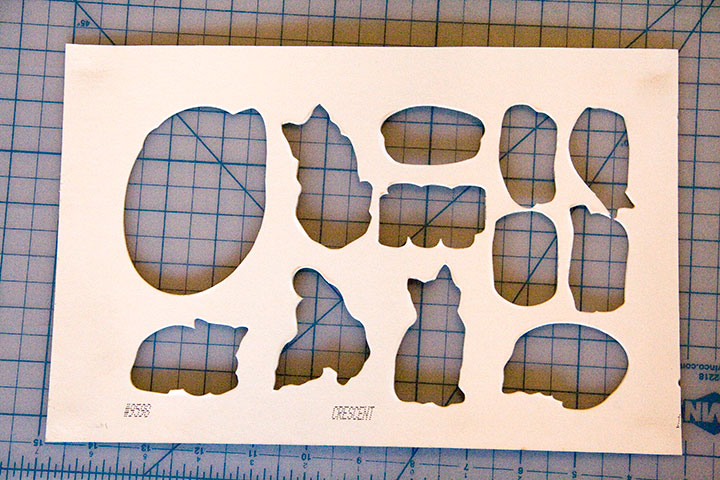
Since the lightweight prints are mounted to a heavier board to complete the ornaments (the ribbon loops are sandwiched in between), I was basically using the die twice. I realized that the leftover blanks of board would make a good template, and wouldn’t wiggle under pressure.
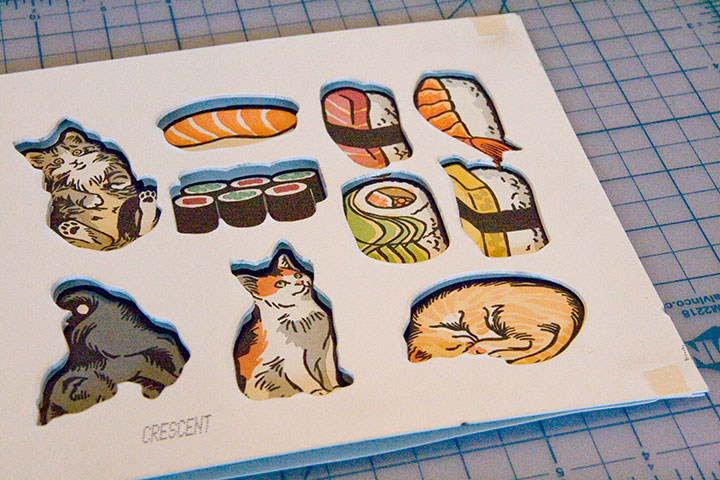
A little masking tape,

some quick eyeballing,
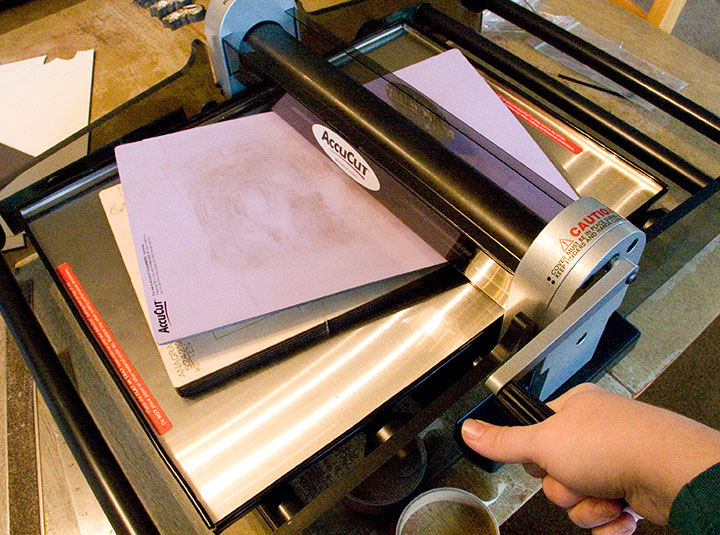
and slow-and-steady cranking in the press—
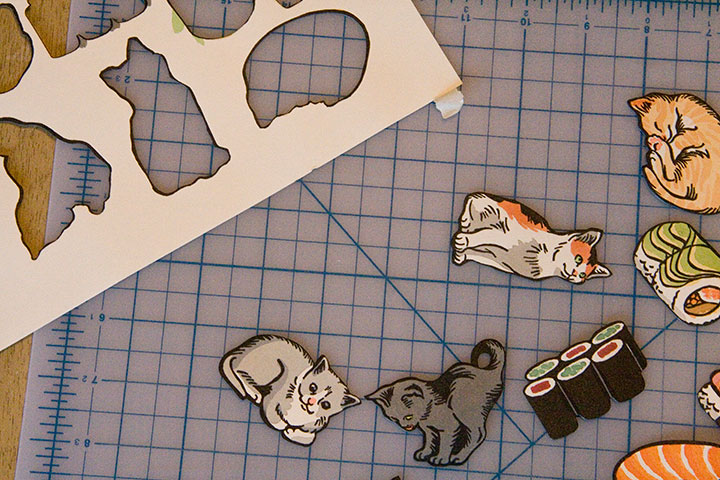
—and Bob, as they say, is your uncle.
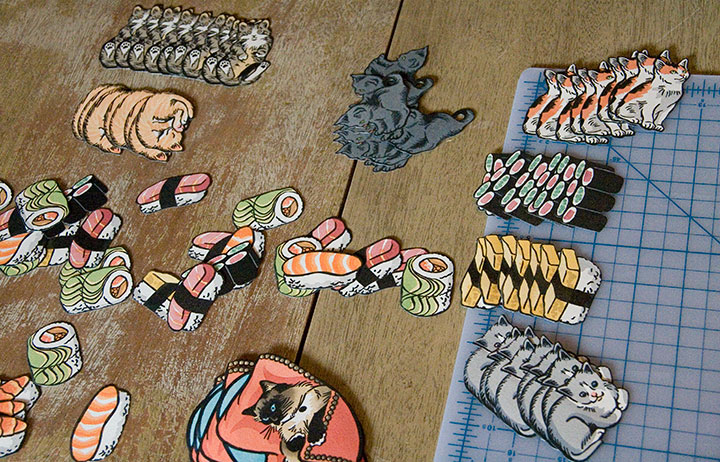
Individually taping down all eleventy billion 200 press sheets was a little mind-numbing, but still, the “finished” pile added up fast.
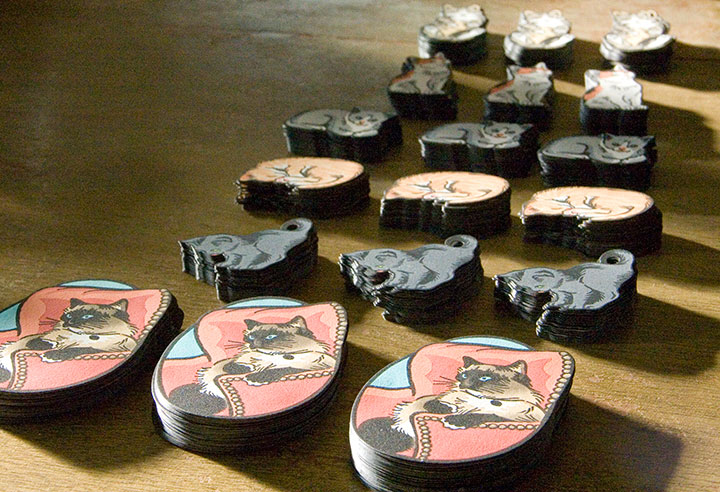
And it was awfully satisfying to see the whole edition completed in days rather than weeks or months.
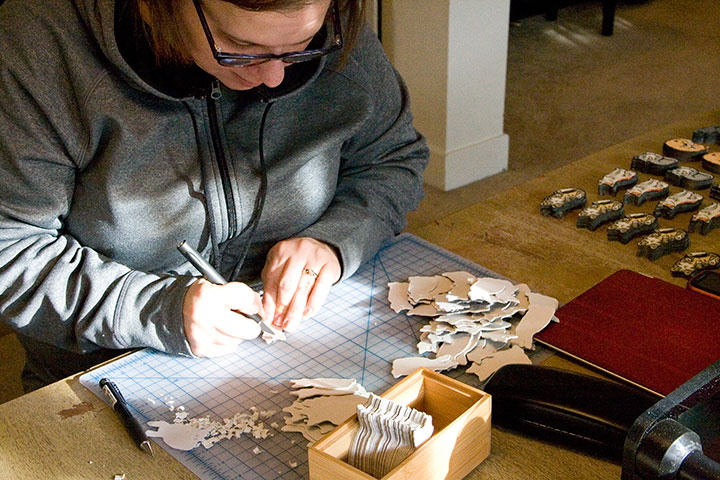
Laurie stepped in and saved my sanity by doing a lot of the grunt work—rough-cutting boards, snipping lengths of ribbon, and cutting insets into the board-kitties so that the ribbon loops lie flush and disappear.
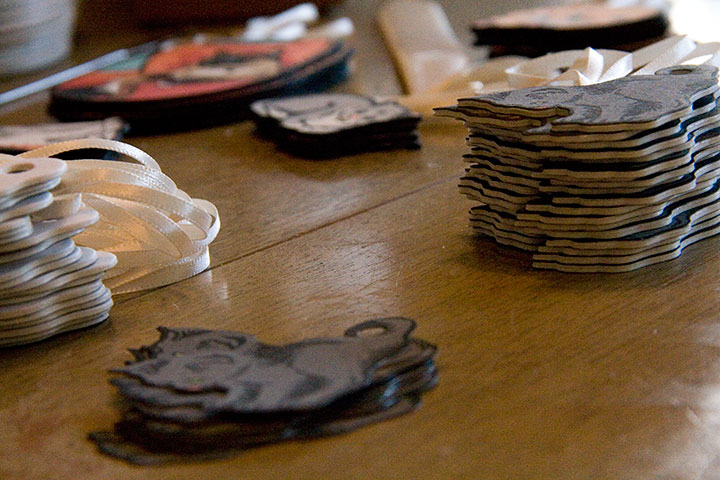
A quick coat of black around the edges,

and just a wee bit of cursive script on the back,
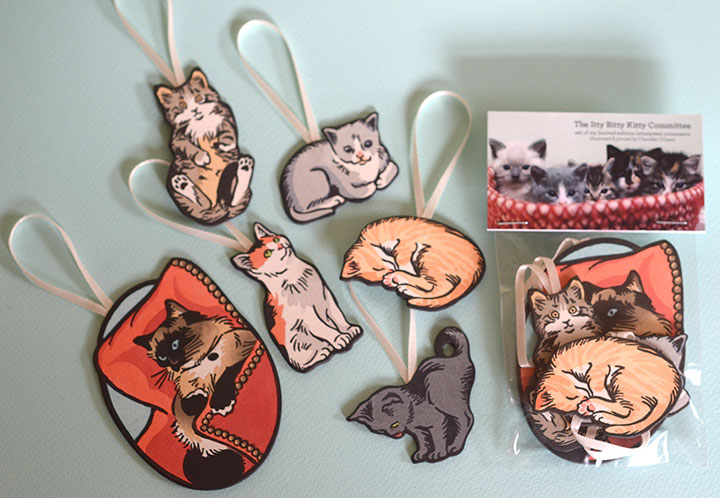
—and we have a litter of Christmas kittens. Laurie contributed one of my favorite photos for the packaging, and I basically have been unable to stop squealing ever since. Now the Tailor and I just need to hurry up and chop down our Christmas tree, so I can display these guys in the living room!
If you’d like a set, they’re up in the shop. To answer the foreseeable question, we’re just offering these in full sets—they were printed in sets, so we don’t really have any oddball solo pieces this time. And last year almost everyone wanted the full set of bird ornaments, rather than just one, so I let those votes carry the motion. Actually, there are still some bird sets left, so feel free to snag ’em if you missed out last year. As usual, these are limited-edition—I won’t be reprinting them, so once they’re gone, they’re gone for good.

One last thing: to make sure that Tacoma pets also have a happy holiday season this year, Laurie and I will be donating a portion of our proceeds to help stock the Tacoma Humane Society’s emergency pet food bank. We want to make sure that while we’re all having a kitty-themed Christmas, the kittens who inspire us get to enjoy Christmas dinner, too.
Happy tree-trimming!
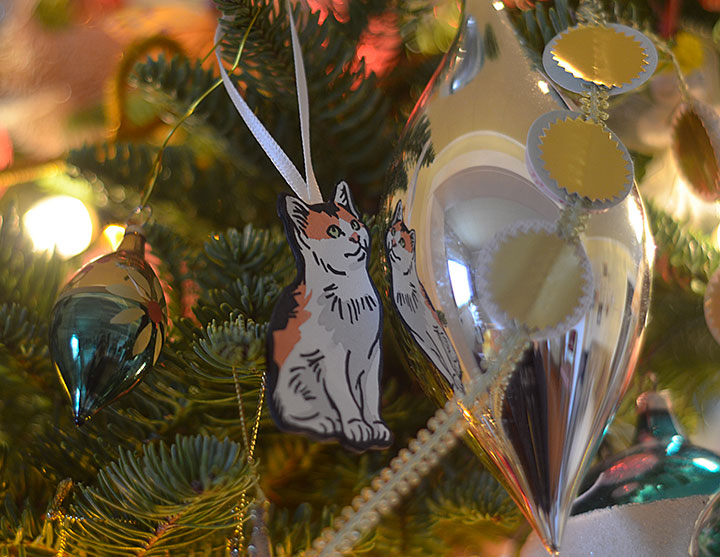
November 1st, 2012
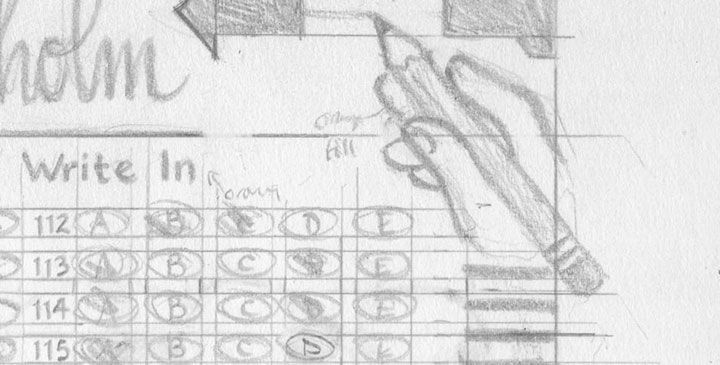
Our pencils are sharp, and our presses are fired up. Jessica and I are churning out our next candidate for Dead Feminist, and she’ll be on the ballot next week. You can catch her online then, or if you’re local, see her first at this weekend’s Studio Tour. Both Jessica and I will be open both Saturday and Sunday, as usual—more info and maps/directions here.
July 6th, 2012
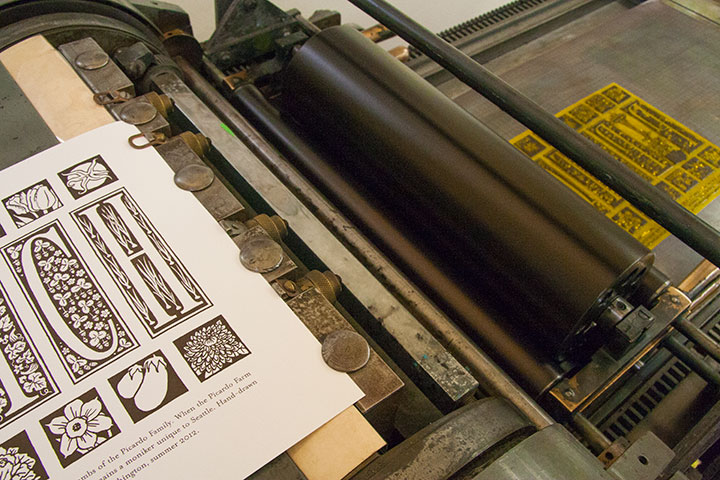
I’m working on a little something in Jessica’s studio right now.
Something that’s making me downright hungry.
I’ll show you the finished product as soon as it’s done—provided I don’t go bury my head in the veggie crisper first!
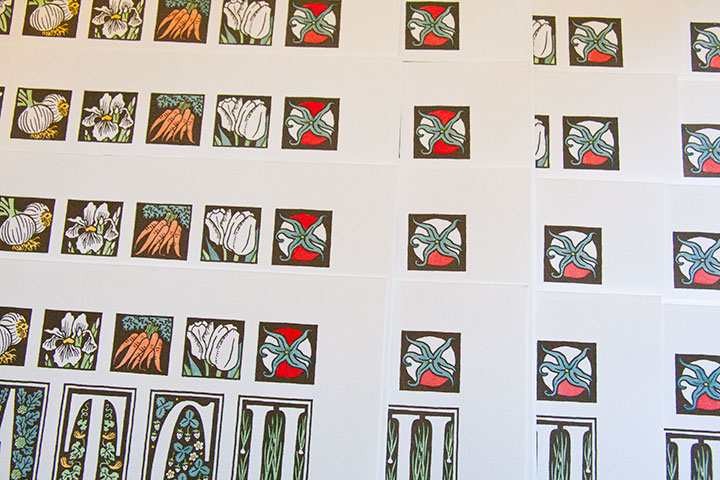
June 29th, 2012
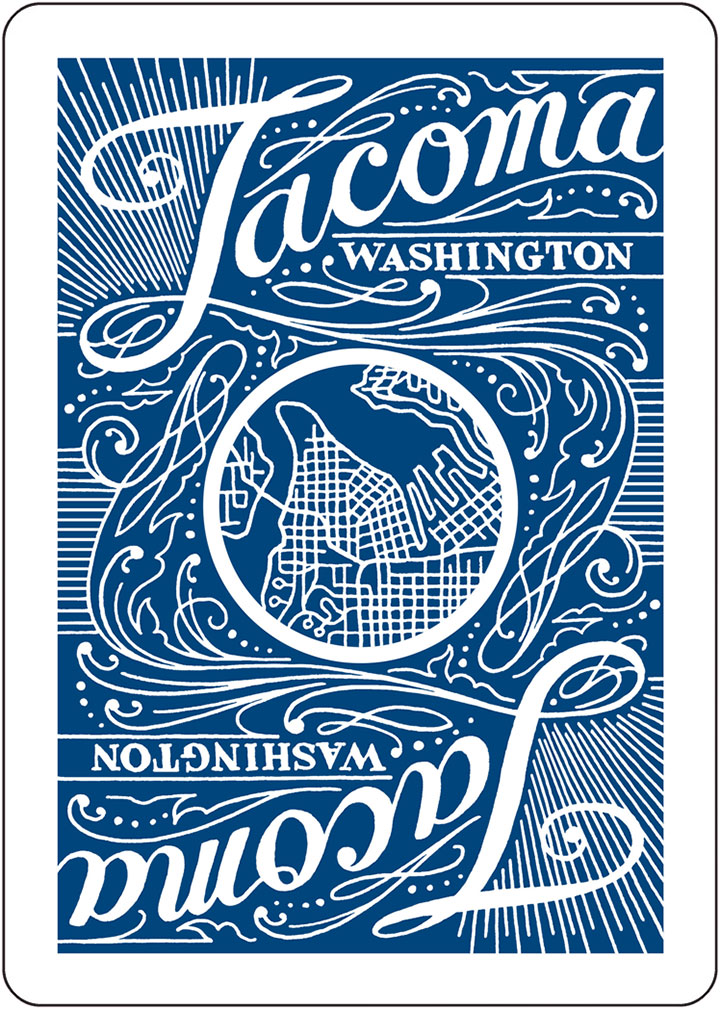
My brain is chock full of useless information—I could sing you about 35,000 ad jingles on key, or recite Jurassic Park or Trading Places or a hundred other movies line-for-line. But don’t challenge me to a game of Poker, because I have a terrible head for card games. I love playing them, and am always up for learning when friends come over a suggest a rubber of something or other. The trouble is, I forget the rules right away—so whenever I sit down to a rematch, it’s like starting at square one.
As an example, I used to do summer stock theatre, and we techies had a tradition of playing Hearts backstage during the sound check. So I played Hearts every night for two months straight, three summers in a row, and I still can’t remember the rules now. (Something about being saddled with the Queen of Spades, and lots of half-joking shouted epithets surrounding that card, but that’s about it.)
Over the years I have learned and forgotten dozens of card games—including Snap, President, Pitch, Five Card Draw, Seven Card Stud, Crazy Eights, Kings Corners, Egyptian Ratscrew, Spades, Slapjack, Pig, Cheat, Five Hundred, Hand & Foot, Whist—and probably plenty of others that I’ve even forgotten the name for.
About the only games I can ever keep in my head are the embarrassingly simple ones like War, Go Fish, Old Maid and Blackjack. Oh, and I can play Cribbage like a fiend, because my dad and his Scottish friend Alex taught me when I was nine or ten. We used to have hilariously cutthroat wee-lass-vs.-grown-man Cribbage tournaments on a regular basis, so how could I ever forget that?
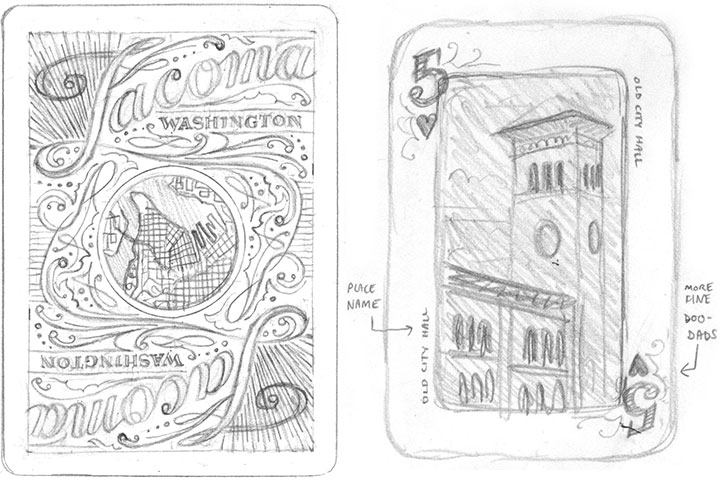
Being lousy at remembering any card games, however, hasn’t stopped me from wanting to design a card game. Or collecting interesting or unusual decks (the Tailor and I have a good dozen in regular rotation). So when my friends Maija and Amy asked me to be the designer on the poker deck they were dreaming up, I think must have freaked them out by shouting, “YES!” before they’d even finished their sentence.
(And as an added bonus, I got first dibs on my favorite Tacoma haunts.)
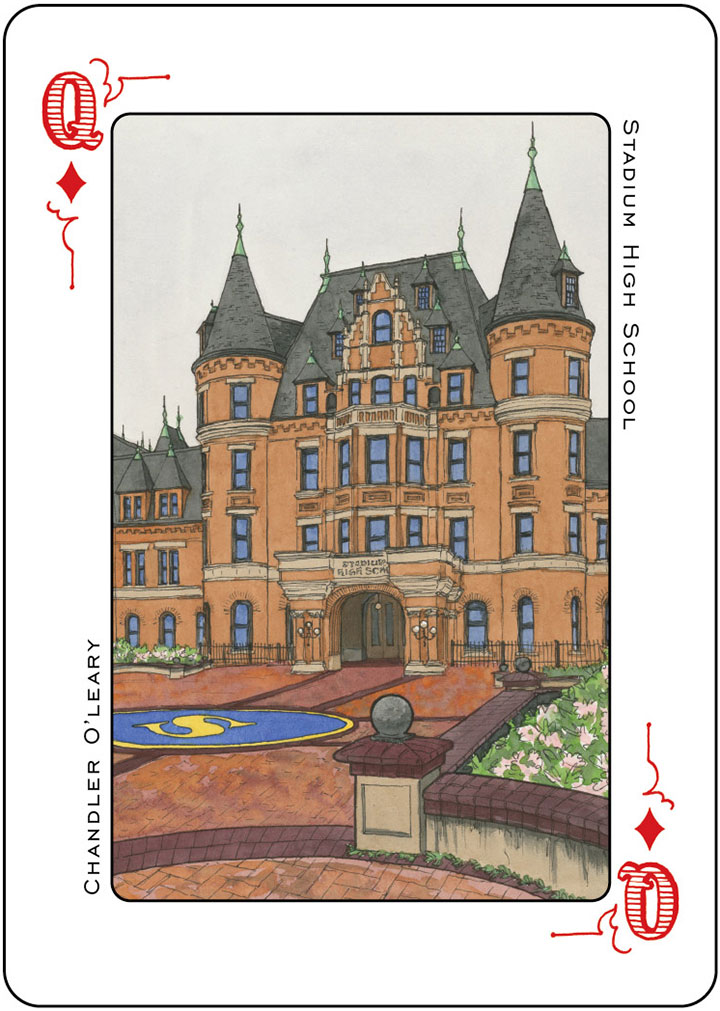
These gals weren’t looking for any old run-of-the-mill card deck, either. They wanted to show off Tacoma in all her architectural splendor. And since we’re blessed with a veritable boatload of fabulously talented artists in this town, they decided to divvy up the deck by ranks—with fourteen artists, each tackling a list of locations in four-of-a-kind fashion. I loved being the first to see the collection of incredible artwork come down the pike from these folks. Everybody involved in the project has gone above and beyond our wildest imagination—I can’t wait to see the finished deck.

Beyond just creating something beautiful and fun, Amy and Maija have their eyes on a bigger prize. They want to create a real, no-kidding Tacoma souvenir. We get a lot of visitors and tourists around here, what with the Sound and the Mountain and the Universities and what-have-you—but you’d be hard-pressed to find Tacoma-specific tchotchkes (or even postcards!) that aren’t sarcastic. And I know I’m not the only one around here who’s a little tired of folks knockin’ T-town, based solely on a stereotype and a thirty-year-old reputation. So we’re upping the ante a little, and offering a bit of hard evidence that Tacoma is pretty dern great.
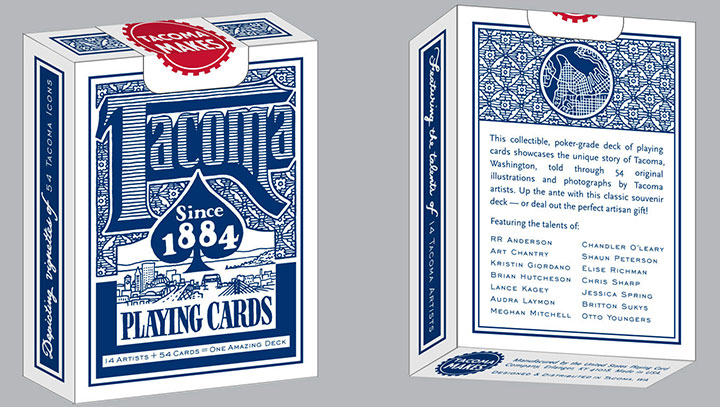
You know my schtick by now, so you can guess that all the lettering and pattern doo-dads are hand-drawn. I had the pleasure of designing the suits, rank typography, card face template, card backs and box.
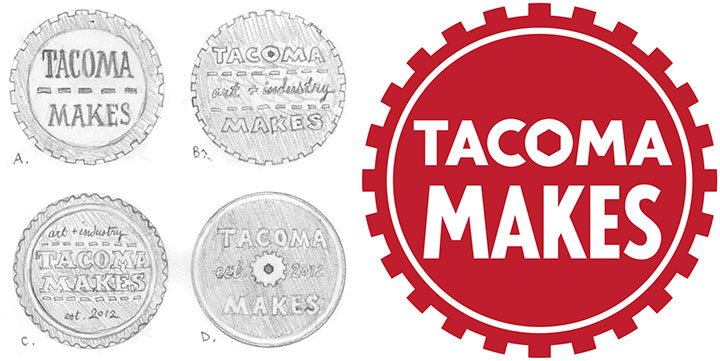
I even got to design the logo for Maija and Amy’s company, Tacoma Makes. Basically, it was the kind of project I’m always on the lookout for, but which rarely lands in my lap. So I spent about half of the time grinning my fool head off, and the other half pinching myself in disbelief.

I also got to flex my file-production muscles. I love to geek out over the technical side of design, but since I started my business, much of my production work has centered around letterpress printing. So playing with dielines and spot color swatches again was a nice little challenge.
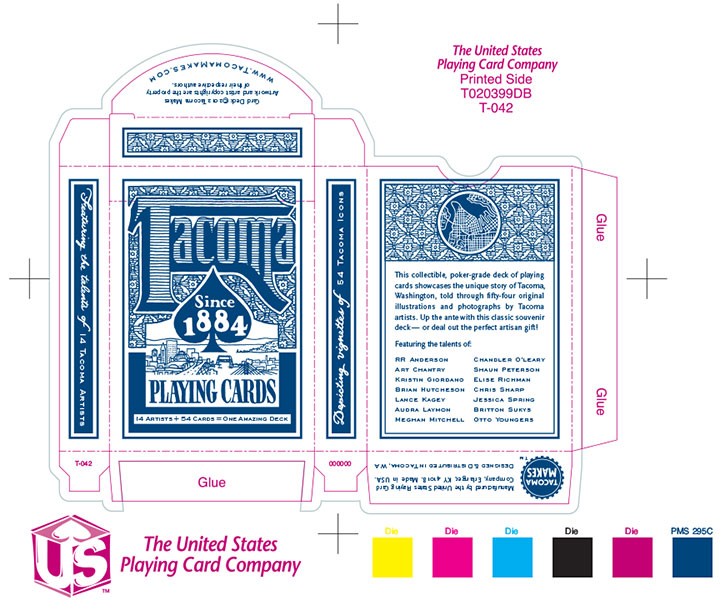
We’re taking all these extra steps because this is a real, bona fide, professional-grade poker deck. The kind folks at the U.S. Playing Card Company are manufacturing the cards for us—they’re the people behind the Bicycle, Bee, Hoyle and other card brands. So you won’t have to hedge your bets that this deck will be extra tasty.

To raise funds for the card printing, and even pay for modest artist contracts, we set up a Kickstarter project (much like the Apocalypse Calendar that you all so graciously funded last year). Now normally this would be where I explain that Kickstarter projects are only funded if they reach their entire monetary goal by the deadline—but I don’t have to! I left town for a few days, just after the project launch, with the intention of spreading the word when I got home. So imagine how floored I was to come back and discover that we’d met our goal in just six days!
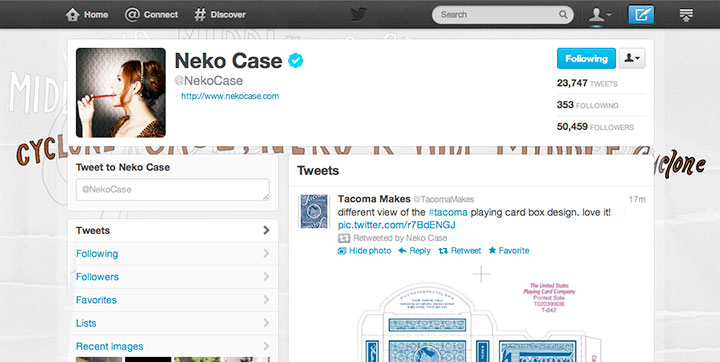
The response to this has been staggering. And it’s not only the lovely legions of fellow Tacomans who have supported us—we’re seeing pledges come in from all over the country. And as a nerdy fan-girl aside, I just have to squeal and tell you that Neko Freaking Case (a hometown Tacoma gal) has been retweeting my designs in the Twitterverse. Dorky internet hero fantasy: fulfilled, folks.

The Kickstarter project will run through July 19, so you can still contribute if you want to get in on rewards and goodies that are only available to backers. Otherwise, the cards will be in hand and dealt out this November—along with an exhibition of all the original artwork.
There’s even a rumor of an artist game night in the works, so cut the cards! I’m up for any game you’re willing to teach me—as long as you don’t mind that I’ll probably forget the rules before the night is through.
In the meantime, thank you so much for all your support for our crazy card deck! I’ve said it before, and I’ll say it again—Tacomans (and honorary Tacomans!) are the best folks on earth.
• • • • • • • • • • • • • • • • • • • • • • • • • • • • • • • • • • • • • • • • • • • • • • • • • • • • • • • • • • • •
Edited to add (fall 2013): The blue deck has been so popular that we have done a red deck as a sequel! The new deck features all new artwork and artists—you can read more about it here.

June 6th, 2012
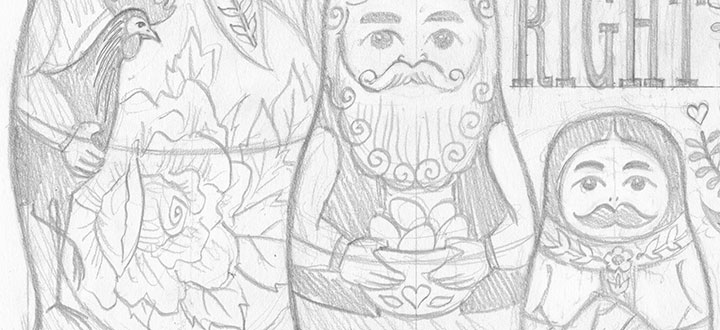
Our new Dead Feminists broadside is coming next week! We’re still printing, which is proving to be a bit of a sticky wicket (as you’ll see), but here’s a snippet for now. Any guesses?
May 25th, 2012
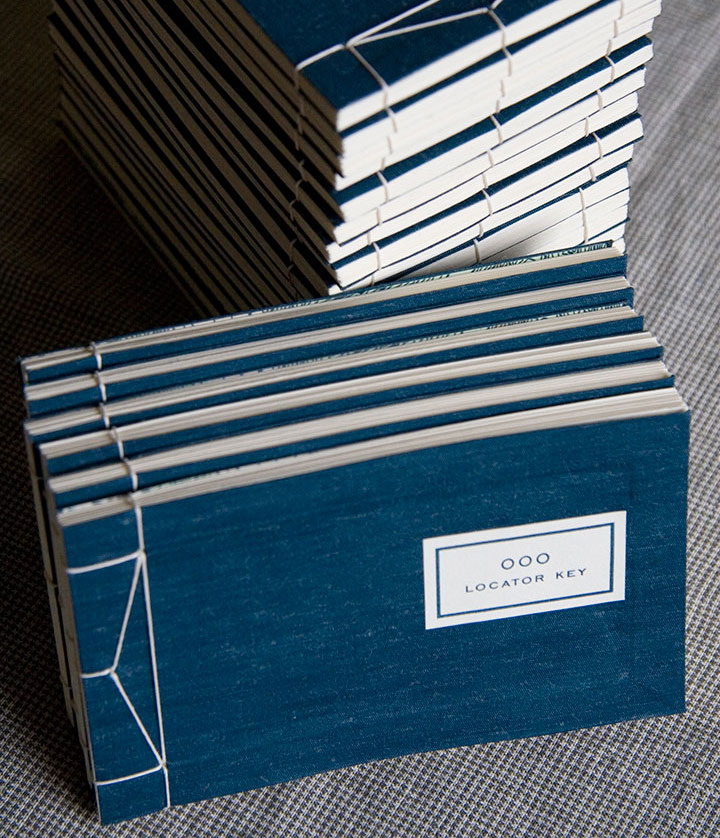
Speaking of keeping busy, looks like I’m not the only one who’s been working on my Local Conditions book. The kind folks at Stanford University put together a little video demonstrating how book works. So now, instead of having to explain it step-by-step, and hope for the best, I can actually show you in real time. Take a gander:
And if you happen to be in the Bay Area, you can see the book for yourself at the San Francisco Center for the Book. From now through August 31, Local Conditions is on display as part of the exhibition Exploding the Codex. The show highlights unusual and unexpected structures by over forty artists—pieces that blow the lid off of the standard definition of what a book can be. I’m sad not to be able to get there myself before the show closes, but if you’re in the area, stop by on June 15 for the opening reception—and tell ’em hello from me.
May 20th, 2012
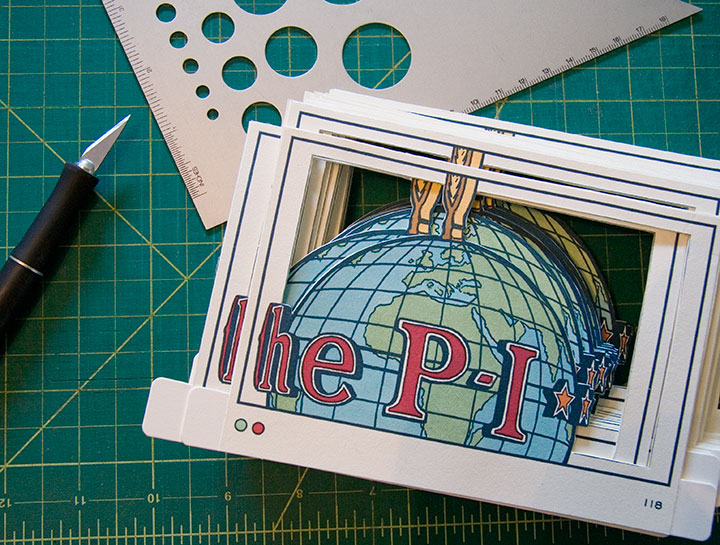
Now that I’m back in town, I’ve got deadlines. Lots of them.
Like, hundreds and hundreds. Each one shaped like a little P-I Globe, a little Space Needle, or any number of things.
You get the idea.
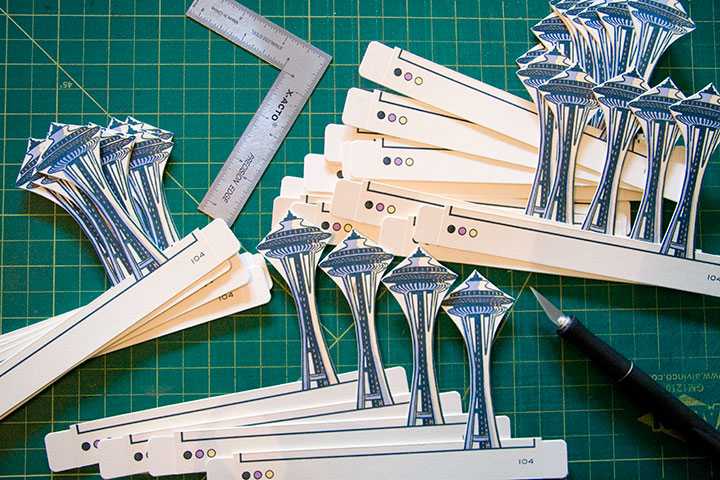
April 9th, 2012
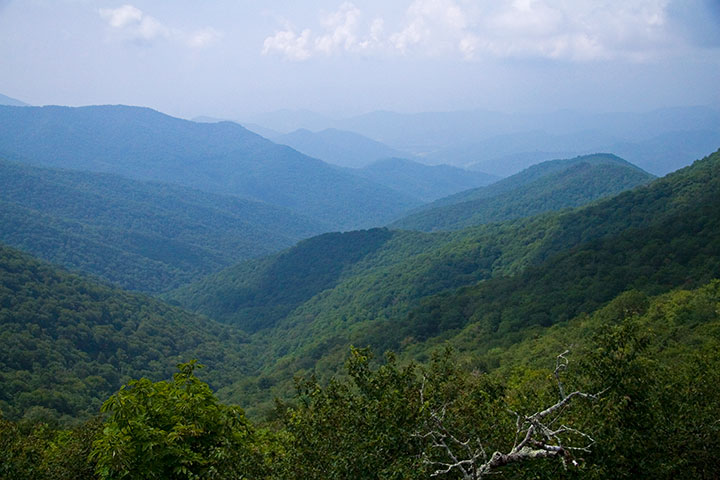
When Jessica and I were in North Carolina last summer, we had just enough sightseeing time to squeeze in a short trip along the aptly-named Blue Ridge Parkway.
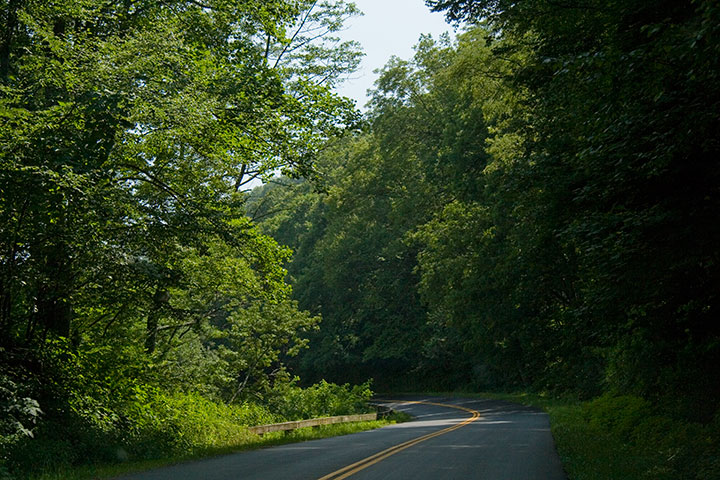
Between the dappled sunlight,
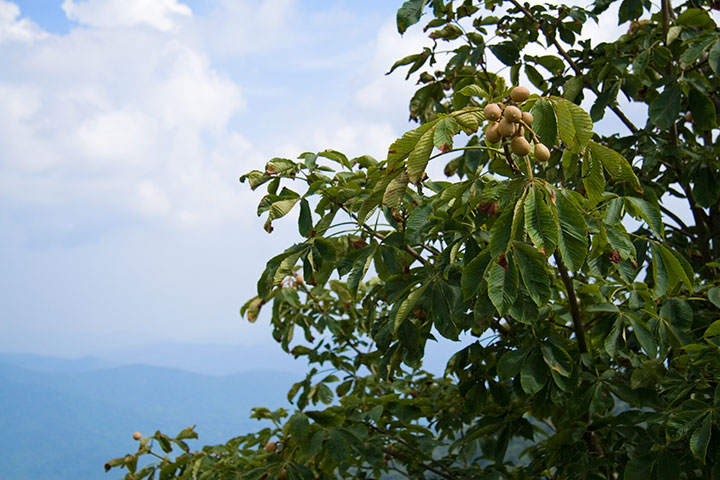
the lush Southern greenery,

and the unexpected splashes of color,
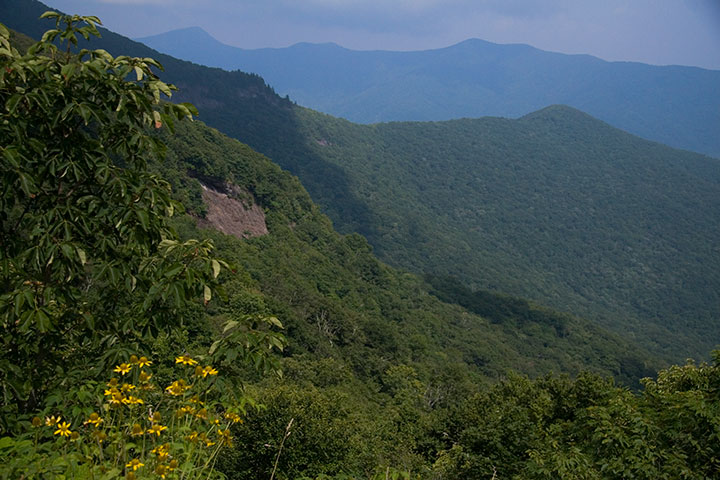
we were enchanted in an instant.
(I, for one, was tempted to do a little Katniss Everdeen impression—just run away from it all and head for the hills.)
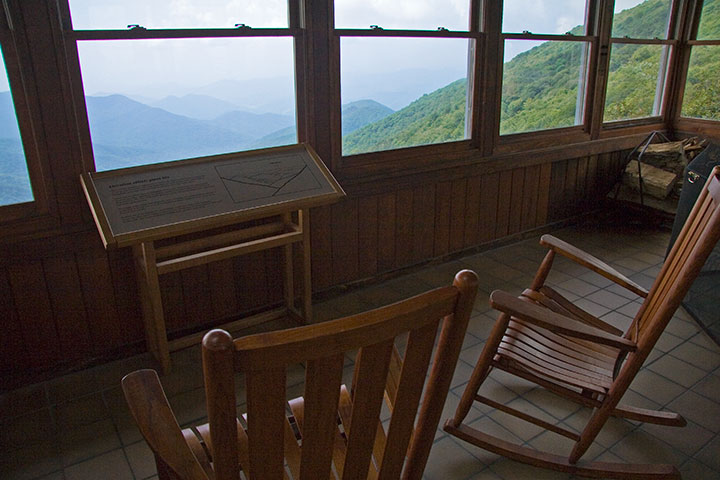
It wasn’t hard to imagine sitting down and breaking out the paper and paints, with all that blue haze as inspiration.
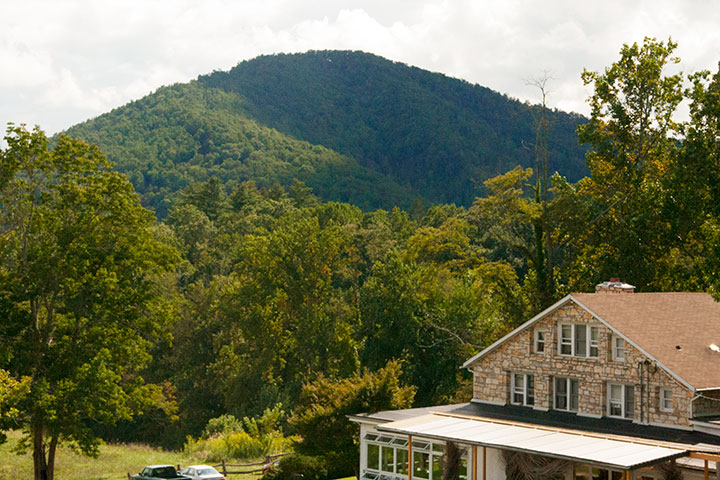
The folks at the nearby Penland School of Craft certainly agree. Since Lucy Morgan founded it in 1929, Penland has become a national center for craft education. Widely respected for its preservation of handcraft traditions, Penland is centered on total-immersion study and both traditional and experimental techniques. Settled in a quiet pocket of the Blue Ridge Mountains, it’s an inspiring setting for focused work. Thanks to its reputation and location, the school attracts some of the country’s best artists and fine craftspeople to study and teach in the Penland studios.
So you can imagine how thrilled and honored Jessica and I were when they asked us to come and teach a letterpress workshop there this summer.
We’ll be teaching a one-week printing intensive, and doing our very best to turn the printshop upside down. This ain’t your grandpa’s letterpress. Here are the details:
Letterpress: Old Dog, New Tricks
A printmaking intensive with Chandler O’Leary and Jessica Spring
Penland School of Crafts, Penland, NC
Summer Session 7: Aug. 26 to Sept. 1, 2012

In the class, we’ll work with both hand-set type (don’t worry, we won’t monkey with any linotype machines…) and photopolymer plates to produce editioned prints that combine the two techniques.
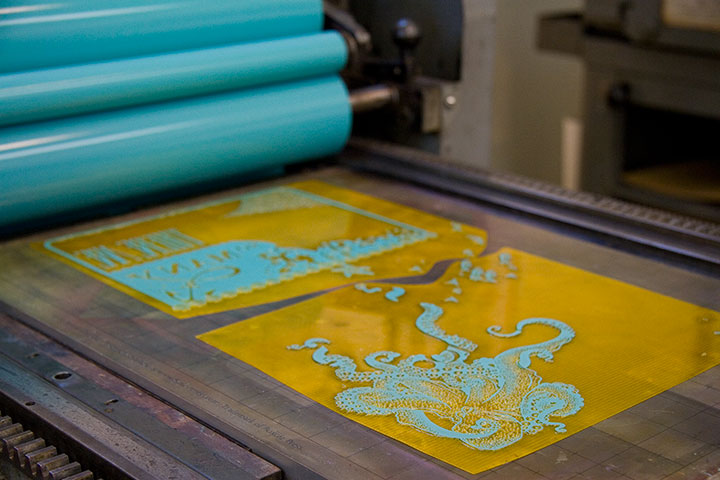
We’re going to get pretty technical, pretty fast, but don’t worry—the workshop is open to all levels of experience. That way we can bring letterpress newbies up to speed quickly, and give more experienced printers the chance to go nuts and geek out with us.
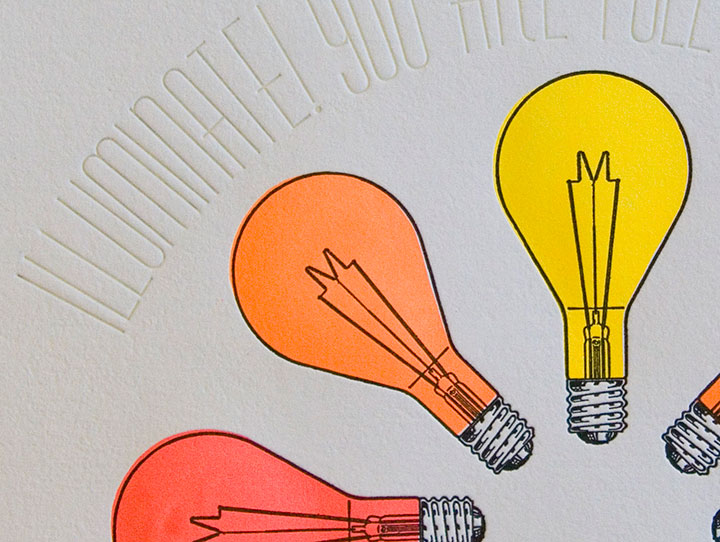
“Unnatural Light” by Jessica Spring
You’ll be doing some death-defying typesetting by hand, using Jessica’s acrobatic techniques,
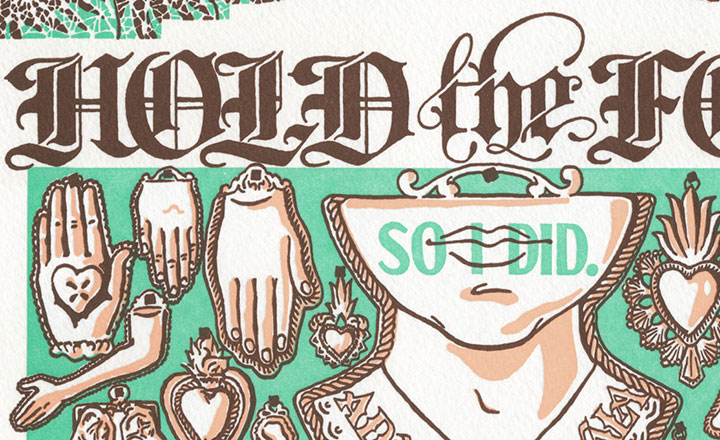
On a Mission Dead Feminist print
and I’ll teach you the ropes of designing for photopolymer, so you can throw a three-ring hand-drawn circus into the mix.
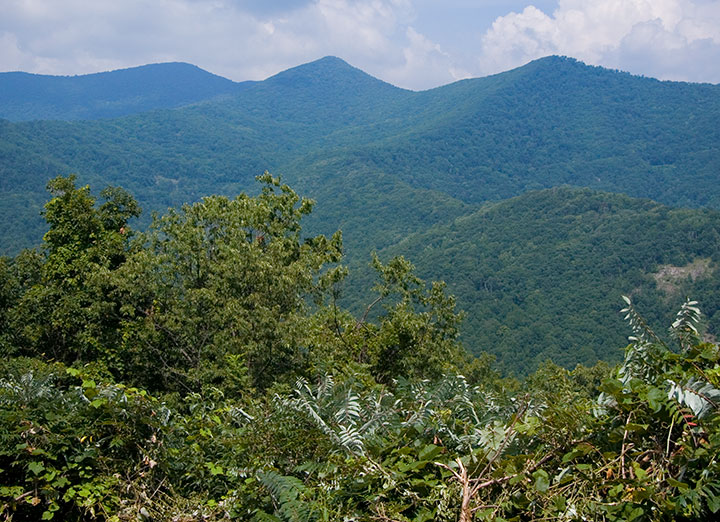
So get thee to the mountains and join us! Registration is open now, but don’t wait too long—the class is capped at 12 students.
See you in North Carolina! Save me some grits, will you?
April 4th, 2012
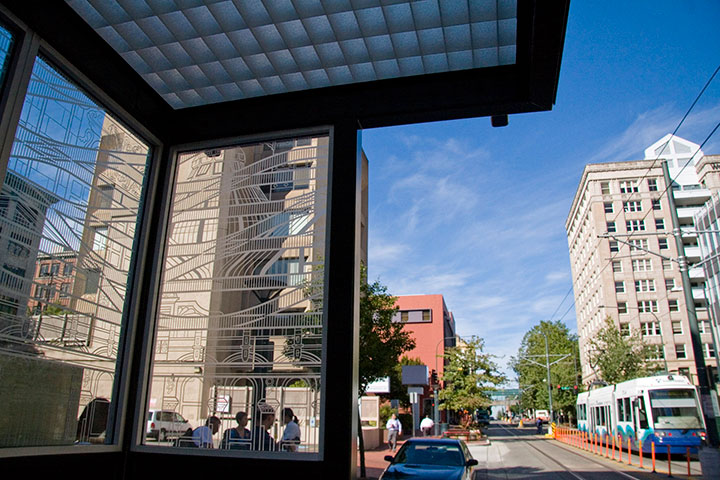
This is rather old news now, but as it took such a long time to complete, and as it isn’t exactly going anywhere, being hot off the press doesn’t matter so much. Last year I was commissioned to do a piece of public artwork here in Tacoma, and as of a few months ago, the Commerce Street light rail station is up and running.
I’ve done several temporary and permanent public pieces before, but this was my first commission for a durable materials project—and by that I mean materials that can be expected to last many decades with minimal maintenance (metal, stone, concrete, ceramics, glass, etc.). Interestingly, painted murals are not considered durable; they require all kinds of upkeep, and have an average life expectancy of only five to ten years.
The Commerce Street Station project called for a design for etched glass. Now, as you’re well aware, I’m no glass artist—it’s a little weird to think of a letterpress printer doing glass work. But that’s the beauty of the public art realm: instead of one artist tackling every aspect of a project, there’s a whole team of people involved, each focused on his or her particular strengths. I was responsible for the design, and industrial fabricators took care of the actual glass-etching part. So what my part boiled down to was a process nearly identical to what I do for any letterpress print: a hand-drawn illustration, converted into a computer file for production. Realizing that created a huge mental shift for me, and suddenly made the prospect of wearing a Public Artist hat way less intimidating.
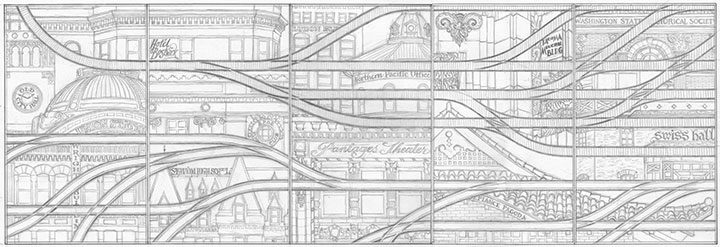
If you’ve ever stood in a shelter waiting for a bus or train, you’ve probably seen an etched glass design. Usually it’s an abstract pattern to discourage graffiti, or in the Pacific Northwest, often something outdoorsy or salmon-themed. So I figured that territory was well covered. Instead, I focused on the rails themselves. The railroad is possibly the single most significant aspect of Tacoma’s history; it is truly the backbone of our city. In 1873, Tacoma was chosen over Seattle as the terminus of the Northern Pacific Railroad. Without the resultant growth and industry that resulted from the railroad hub, Tacoma might still be a tiny fishing hamlet, rather than a bustling port.
For decades, industrial and passenger rail travel was our pride and joy. Along with the goods and people moving along the NP Railroad line, Tacoma was also criss-crossed with streetcar lines, providing efficient and comprehensive public transportation. During the Great Depression, however, the cost of maintaining the streetcar lines became too heavy a burden. The system was dismantled in 1938, and private automobiles became the dominant mode of transportation. This story is by no means unique — passenger rail fell out of favor all over the country, and today, public rail transit is only the norm in our largest cities.
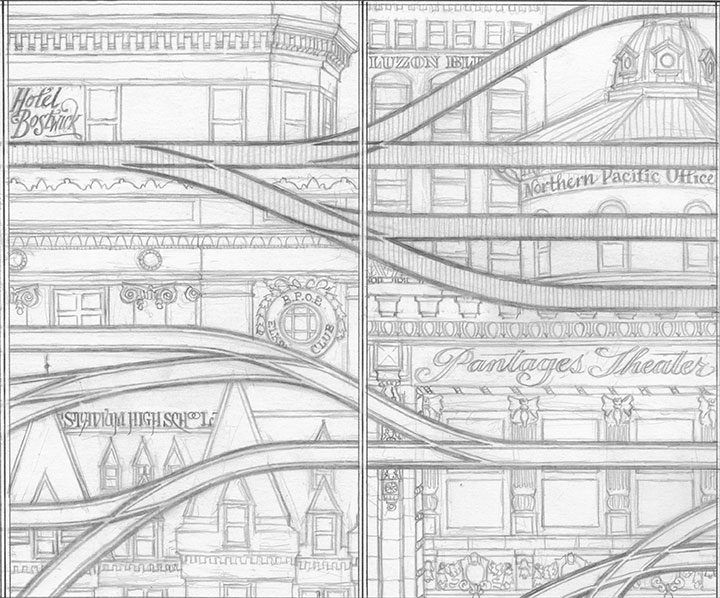
To me, our small (but expanding) light rail line is a ray of hope for a progressive future, a return to a more sustainable system, and a chance to highlight Tacoma’s history. So for Continuum, I designed a brace of parallel rail lines. The top line is a set of traditional railroad tracks, beginning as a single thread and branching outward—symbolizing Tacoma’s beginnings and expansion. The bottom tracks are grooved-rail embedded tram tracks—exactly the type you see in both old streetcar lines and modern light rail paths. As the traditional tracks branch outward, the tram tracks converge into a single path, just as our lone light rail line is the last vestige of the old streetcar network.
Tacoma’s architecture sprouted and developed right alongside the railroad, as a result of our industrial growth. So instead of surrounding the tracks with a white-noise pattern of ballast, like you’d see around real tracks, I designed an illustrated amalgam of our most iconic buildings. Some are still with us; others are long gone (can you spot the Luzon Building above?). Every structure represented exists either along a historic streetcar or other track line, or has some connection with the railroad.
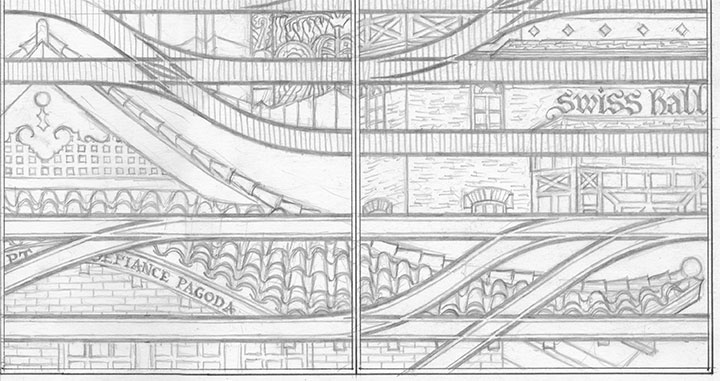
While I was working on the initial design, a teenage arsonist set fire to the historic Pt. Defiance Pagoda. Suddenly it didn’t seem to be enough for the city merely to preserve the architecture—I felt the need to create my own record of as many buildings as I could.
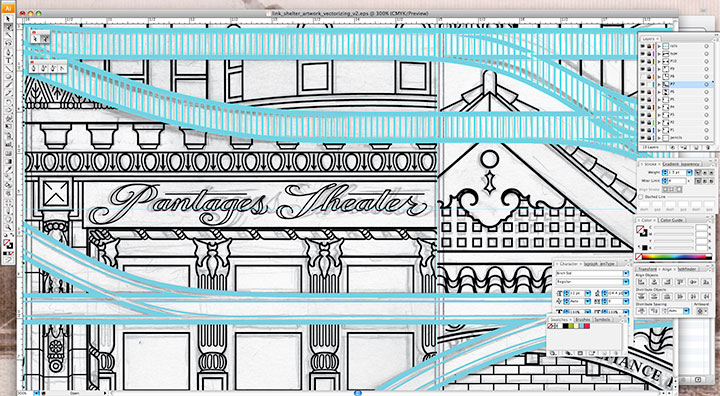
My pencil drawings weren’t finished enough to send to the fabricator—I needed to bridge the gap between my pencil and their equipment. To get the artwork to the point where it could be etched into glass, I needed to convert it to a specific file format called vector graphics. Now, digital photos are made up of pixels: a grid of tiny dots that determine how large a size an image can be blown up to be. The more pixels per square inch, the larger you can make the photo. Vector art doesn’t work like that. Without getting in over my head in explaining this, vector graphics are made of math.
(Which is super cool, really.)
The shapes are determined by geometric points, lines and proportions, rather than pixels. So that means you can blow the artwork up to any mammoth size, or shrink it as small as you please, and you’ll never lose detail or image quality. This makes the vector format A) awesome; and B) ideal for translating extremely intricate work into industrial materials. All I had to do was fire up Adobe Illustrator, and get to work converting the artwork.
This took days. And days. And days.
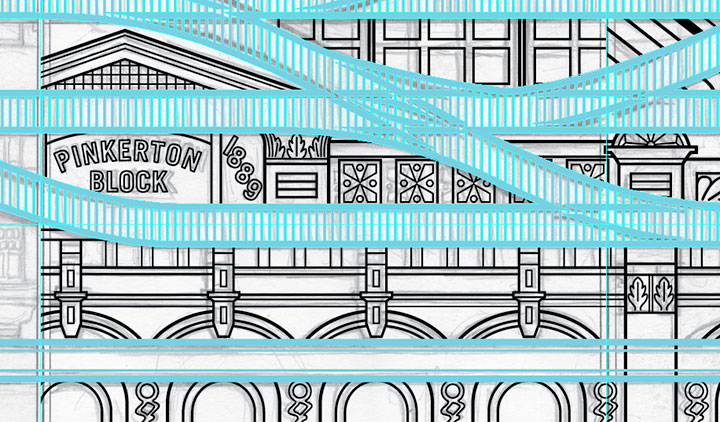
It’s funny that people tend to see computer programs as shortcuts or “cheats,” but in the end, any good piece of digital artwork requires a level of craftsmanship—exactly the way a handmade object does. Illustrator has lots of labor-saving tools if you know where to look, but the ones that are designed to fully automate the conversion from a scanned drawing to a vector file aren’t always ideal. For this particular project, the only way to do it right was to suck it up and spend ungodly hours redrawing the thing “manually” within the program. I had to rely on all my artist chops just as much for file production as I do for any artist book or watercolor painting. I easily spent as much time converting the design to vector format as I did drawing it by hand, but it’s important to have a flawless file—lots of expensive production steps are dependent upon that file being free of glitches or stray marks.
As an aside, one night that I stayed up (very) late working on the file happened to be the night of the Royal Wedding. To provide some background noise (in order to stay sane), I streamed the event in a little window on the corner of my screen while I worked. So now, whenever I see the finished glass panels I think of ridiculously ornate English hats, and the Queen in her vanilla Jello pudding-colored suit. Pavlov would have a field day with me.
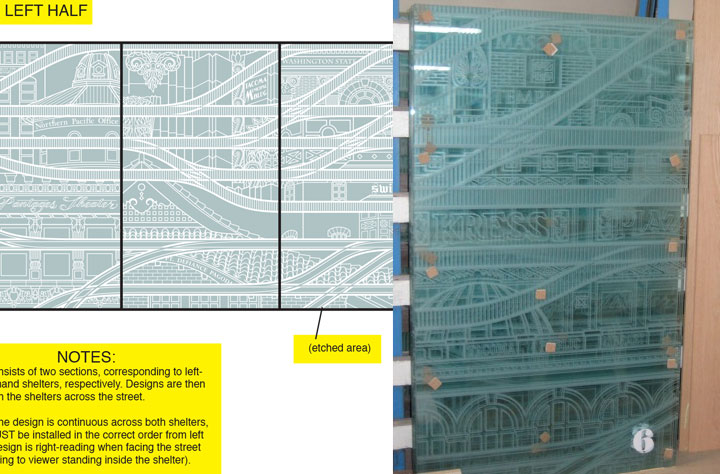
Right-hand photo courtesy of City of Tacoma
Anyway, next I sent the finished files to the fabricator. Using the points plotted in the file, and a digital mockup I threw together with my production notes, they were able to cut the design out of a masking material, which they attached to the glass. Then the sand-blasted the glass panels. Where there were holes cut through, the sand made contact and etched the glass; everything protected by the mask stayed shiny and transparent. The finished result is a clean, precise replica of my design.
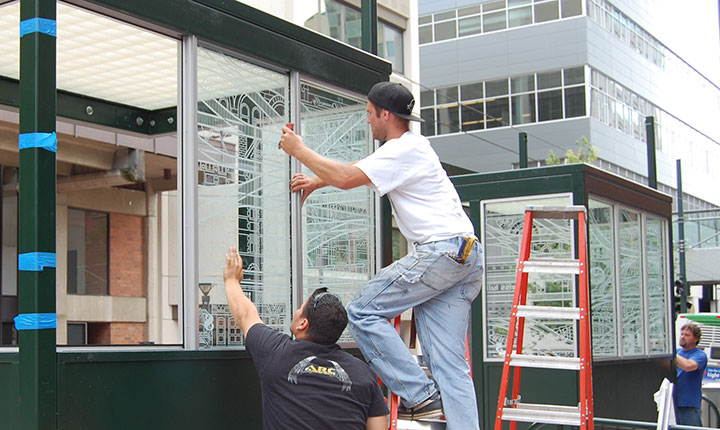
Photo courtesy of City of Tacoma
The tricky part was making sure they installed all ten panels in the correct order; otherwise the connecting track lines wouldn’t make sense. Thanks to the big fat numbers they stuck to each panel, though, everything worked out just fine.
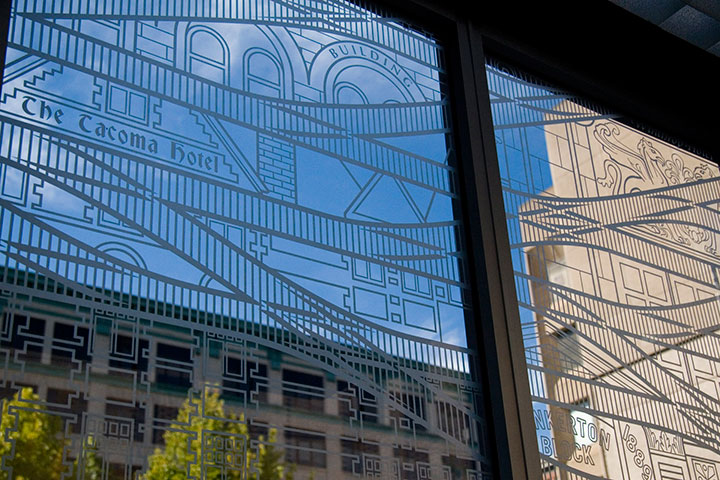
It’s fun to stand inside the finished shelter, and see the stylized buildings contrast with real ones. And when you’re not paying close attention to the details, the illustrations recede into a sort of geometric pattern.

For those who are paying attention, my hope is that this little illustrated city will encourage viewers to notice the real city around them—preferably with an eye toward preservation and innovation.
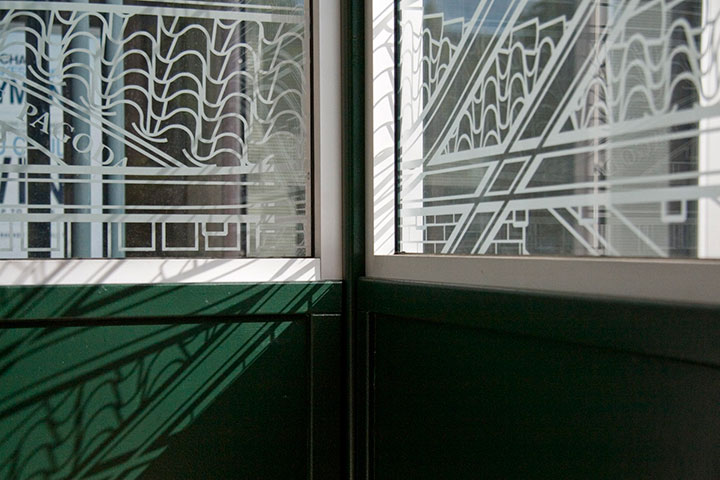
Attentiveness has its own little reward, too. If you happen to be there when direct sunlight hits the glass, the etched lines project onto every surface. (Tacoma looks good on you.)
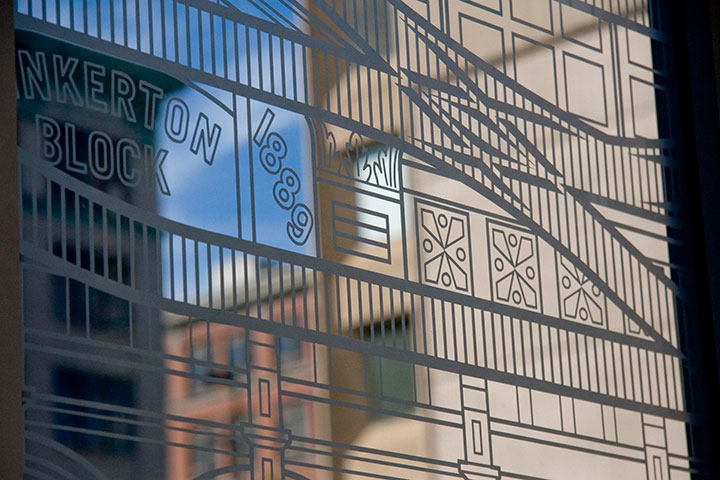
In the end, I just wanted to take the dull routine of waiting for a train, and turn it into something beautiful—even if only for a moment.
I’m always saying things like, “If I ran the world…”, usually followed by some crazy idea for transforming every mundane thing in life into something a little more meaningful. I love the thought that on one tiny patch of real estate, I really did get to run the world, and make things exactly the way I imagined they could be. Many thanks to Amy McBride and the City of Tacoma for giving me free rein.
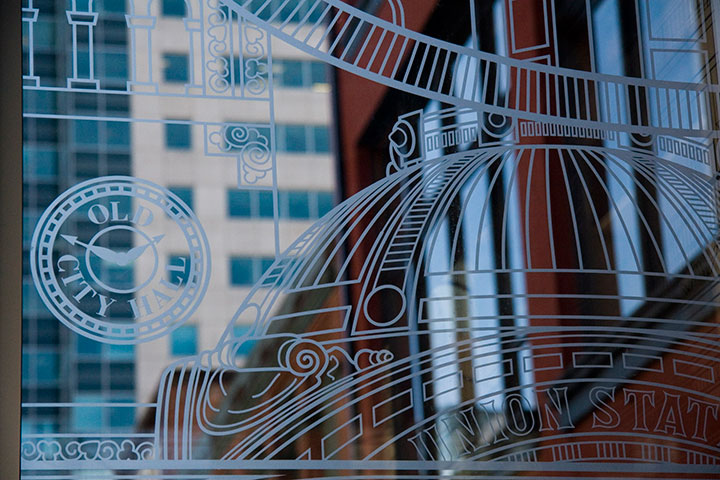

![Chandler O'Leary [logo]](https://chandleroleary.com/wp-content/themes/chandleroleary/images/logo.png)














































































